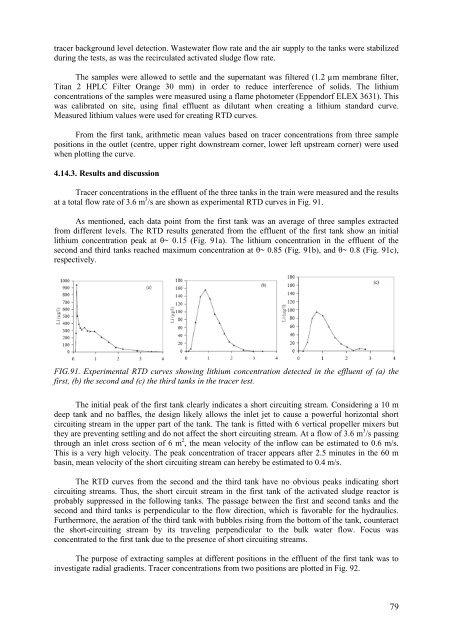Download file - Ayuntamiento de Zaragoza
Download file - Ayuntamiento de Zaragoza
Download file - Ayuntamiento de Zaragoza
Create successful ePaper yourself
Turn your PDF publications into a flip-book with our unique Google optimized e-Paper software.
tracer background level <strong>de</strong>tection. Wastewater flow rate and the air supply to the tanks were stabilizedduring the tests, as was the recirculated activated sludge flow rate.The samples were allowed to settle and the supernatant was filtered (1.2 µm membrane filter,Titan 2 HPLC Filter Orange 30 mm) in or<strong>de</strong>r to reduce interference of solids. The lithiumconcentrations of the samples were measured using a flame photometer (Eppendorf ELEX 3631). Thiswas calibrated on site, using final effluent as dilutant when creating a lithium standard curve.Measured lithium values were used for creating RTD curves.From the first tank, arithmetic mean values based on tracer concentrations from three samplepositions in the outlet (centre, upper right downstream corner, lower left upstream corner) were usedwhen plotting the curve.4.14.3. Results and discussionTracer concentrations in the effluent of the three tanks in the train were measured and the resultsat a total flow rate of 3.6 m 3 /s are shown as experimental RTD curves in Fig. 91.As mentioned, each data point from the first tank was an average of three samples extractedfrom different levels. The RTD results generated from the effluent of the first tank show an initiallithium concentration peak at θ~ 0.15 (Fig. 91a). The lithium concentration in the effluent of thesecond and third tanks reached maximum concentration at θ~ 0.85 (Fig. 91b), and θ~ 0.8 (Fig. 91c),respectively.FIG.91. Experimental RTD curves showing lithium concentration <strong>de</strong>tected in the effluent of (a) thefirst, (b) the second and (c) the third tanks in the tracer test.The initial peak of the first tank clearly indicates a short circuiting stream. Consi<strong>de</strong>ring a 10 m<strong>de</strong>ep tank and no baffles, the <strong>de</strong>sign likely allows the inlet jet to cause a powerful horizontal shortcircuiting stream in the upper part of the tank. The tank is fitted with 6 vertical propeller mixers butthey are preventing settling and do not affect the short circuiting stream. At a flow of 3.6 m 3 /s passingthrough an inlet cross section of 6 m 2 , the mean velocity of the inflow can be estimated to 0.6 m/s.This is a very high velocity. The peak concentration of tracer appears after 2.5 minutes in the 60 mbasin, mean velocity of the short circuiting stream can hereby be estimated to 0.4 m/s.The RTD curves from the second and the third tank have no obvious peaks indicating shortcircuiting streams. Thus, the short circuit stream in the first tank of the activated sludge reactor isprobably suppressed in the following tanks. The passage between the first and second tanks and thesecond and third tanks is perpendicular to the flow direction, which is favorable for the hydraulics.Furthermore, the aeration of the third tank with bubbles rising from the bottom of the tank, counteractthe short-circuiting stream by its traveling perpendicular to the bulk water flow. Focus wasconcentrated to the first tank due to the presence of short circuiting streams.The purpose of extracting samples at different positions in the effluent of the first tank was toinvestigate radial gradients. Tracer concentrations from two positions are plotted in Fig. 92.79
















